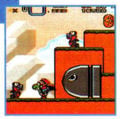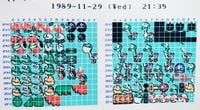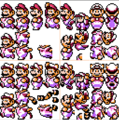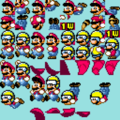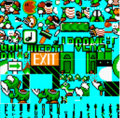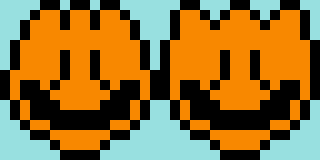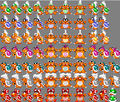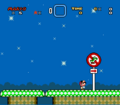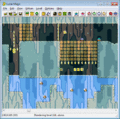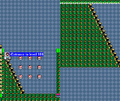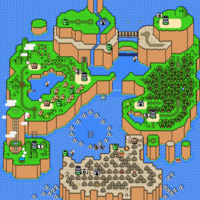List of Super Mario World pre-release and unused content
It has been requested that this article be rewritten. Reason: Strange phrasing, poor formatting (tagged on December 27, 2024)
This is a list of pre-release and unused content for the game Super Mario World. For pre-release and unused content pertaining to the remake, Super Mario World: Super Mario Advance 2, see Super Mario World: Super Mario Advance 2 § Pre-release and unused content.
Early builds[edit]
Magazine and TV previews[edit]
In preview builds of Super Mario World before the game's release, Dinosaur Land was drastically different than the final version. It was a large landmass shaped like a Super Mushroom, and its landscape was relatively flat, which made it more closely resemble the various worlds of Super Mario Bros. 3. This version of Dinosaur Land featured locations such as Toad Houses (which could possibly mean that Toads were once considered to populate Dinosaur Land) and Fortresses based directly on those from Super Mario Bros. 3. In addition to this, the game originally had the subtitle "Super Mario Bros. 4".[1]
An early screenshot of Dinosaur Land from Super Mario World. Notice the coin and score counter.
Another screenshot of the early version of Dinosaur Land. Notice the counters again.
An early level of Super Mario World, most likely Yoshi's Island 1
Test cartridges[edit]
The Nintendo World Class Service Program used test cartridges for the Super Nintendo Entertainment System, such as the NTF 2.5 Test Cartridge and Burn-in - Test Cartridge, to diagnose hardware issues with the console. Among other things, these cartridges include leftover graphics from early builds of Super Mario World. The graphics reveal that, at one point, Goombas would have been stompable like their original counterparts, and Venus Fire Traps would have made a return from Super Mario Bros. 3. The Super Leaf power-up and Raccoon Mario form were both present, but appear to have been replaced by Caped Mario in the final game, which functions similarly to Raccoon Mario. Finally, other block types such as Brick Blocks and dungeon tiles would have been directly updated from the previous game.
Sprite documents[edit]
In an interview, the developers of Super Mario World revealed two pictures depicting early sprite tiles for the game. Nipper Plants, Chain Chomps, Sledge Brothers, and Hammer Brothers are present on the sheet, the last of which is inconsistently shown with or without shoes between frames, showing that these sprites were not considered complete even before scrapping. Alongside this, green and yellow blob-like creatures were also shown. It is likely that the blobs would have been early versions of Baby Yoshis. Additionally, a full-grown Yoshi is shown with a head similar to the final version's Baby Yoshis, and that Mario was originally going to punch Yoshi's head in order for him to either extend his tongue or breathe fire. A Super Mario Bros. 3-styled Lift is also shown among the early sprites. Other sprites included a black ball-shaped creature with white eyes and two stick-like feet, a red Power Balloon, a more on-model Cheep Cheep, and circular and square variations of the Triangular Block.[2] Later, in late July of 2020, the source code of select Super Famicom games were leaked, including Super Mario World, and shows many concepts and sprites showing various entities in different stages of creation, some of which go entirely unused.[3] These include:
- An elderly blue Yoshi
- Early versions of the Koopalings that would have shared a unified attack pattern much like in Super Mario Bros. 3 while being based particularly on Ludwig's battle in the final release
- An early version of Cape Mario with a red cape and a helmet
- A shorter Torpedo Ted that would have been the same size as a Bullet Bill
- A cannon enemy that would have predated the Kaboomba enemies from Super Mario World 2: Yoshi's Island
- Earlier iterations of Blargg that included a shark and a water-dwelling dinosaur
- A gigantic Banzai Bill that would have predated the King Bill enemies from New Super Mario Bros. Wii
- A crocodilian Koopa Troopa that would been distinguishable from previous enemies similar to the game's Goombas
- Clearly unfinished Para-Beetles
- Shark enemies that were replaced by the Dolphins (with them bearing a vague resemblance to, and predating, Guppy from Super Mario Galaxy)
- Clearer versions of the above sprite documents
- A scrapped Big Buzzy Beetle that would have predated its appearance in Paper Mario: Sticker Star by 22 years
- A Toad-like flower character that would have predated the Poplins by 33 years
- Bowser being outside of his Koopa Clown Car
- A dummy of Peach resembling the dummies in the fights against Lemmy and Wendy
- An exaggerated sprite of Peach screaming
- A text balloon meant for the Sumo Bro enemies whenever they stomped
- An unfinished dinosaur-like enemy
- A yellow nest-like object that would have been used in the scrapped intro that features the "No Yoshi" sign for Yoshi to rest on
- Sprites of Lemmy that include one of him using a fan with the pattern of the Japanese flag on it
- An early design for Larry, a Bonus Block with a 1-Up Mushroom emblazoned on it rather than the final game's star
- Sprites of Wing Mario predating his appearance in Super Mario 64 by six years
- Mechakoopas with white hair
- Pokeys resembling how they looked in Super Mario Bros. 2
- An early green Wiggler with a relaxed facial expression and spikes on its back as well as a party hat rather than the final game's flower
- Rocky Wrenches making their return prior to the first Super Mario Maker
- An early Lakitu with a smaller cloud similar to previous games
- A creature resembling a Micro-Goomba
- Four Airship-esque vehicles
- A tube-like cannon that fires Koopa Shells
- Sprites of the Mario Bros. based on their Super Mario Bros. 3 sprites
- A background portrait of presumably either Larry or Ludwig meant for Ghost Houses
- A cut Venus Fire Trap enemy (with one variant having eyes)
- A bottom part of the Goal Gate that was cut and replaced by graphics for the background bushes
- A Switch Block-like button that would have functioned similar to the final game's ON/OFF Switches
- A bird-like creature that seems to be carrying something
- A scrapped Piranhacus Giganticus whose design would have predated the ones from Mario Kart 64's Mario Raceway
- Two sets of sprites that replace Mario with Kawasuo-kun from Utsurun Desu, one of which depicts him naked from the neck down
- Sprites of Luigi Super Mario All-Stars + Super Mario World, with one of them depicting Luigi supposedly giving a thumbs-up being unused
Early enemy sprites, notably including many revisions of Blargg, including as a shark
Sheet showing early Koopa Troopas and Hammer Brothers
Early sheet of Bowser, the Koopa Clown Car, Mechakoopas, and what appears to be a Venus Fire Trap with eyes
An early sheet of Small Mario
An early sheet with Boss Bass and a Bullet Bill-sized version of Torpedo Ted
A giant Banzai Bill that occupies most of the screen, predating the King Bill 19 years later
An early sheet with Mask Koopas' masks being generic instead of resembling Mario's head, as well as traditional-type Goombas
Venus Fire Trap and upright Piranha Plant, which are not featured in the final game
An early sheet of capless Mario and Princess Toadstool
An enemy resembling a Fire Flower with Mario's face, seemingly replaced by Jumping Pumpkin Plant
A flower-headed, Toad-like creature, supposedly meant for the Fall theme of Piranha Plant
Early Bony Beetles that had a visible beak
Unused data[edit]
Unused levels[edit]
The ROM file for the retail release of Super Mario World contains many levels that cannot be played in the finished game. The majority of these levels are not referenced by the game's level pointer table, which means that a standard copy of Super Mario World will not be able to play them, even though their data is present. This also means that most of the levels do not have names; therefore, they are listed here by their address in the ROM.
| Image | Name | Description |
|---|---|---|
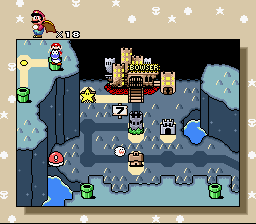
|
Red Switch Palace | There is an unused Switch Palace to the left of Valley of Bowser 3. Since it leads to an "empty" level, it is likely that it was scrapped early in development. Beating the Secret Exit of Valley of Bowser 3 causes Mario to walk to this switch palace, except that Valley of Bowser 3 has no secret exit, and there is no path for Mario to walk on. This glitches the game, causing the player to be teleported to level 00 and get trapped in an endless bonus game. If the player finds a way onto the Switch, the level can be entered; it is nearly identical to Level 0x30200 (the "TEST" level), except that it has a garbled background. |
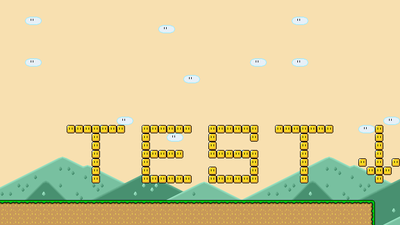
|
Level 0x30200 | This is one of the few levels referenced in the pointer table; in fact, around half of the references in the table are directed to this level. Due to this, this was one of the first unused levels discovered. The actual level is a short plain with TEST spelled out in turn blocks in the sky. At the end is an arrow pointing into a pit. Mario will also receive a 1-up if he either walks to the end of the level or slides down the side of the first T, but he cannot receive both. In the copy that was originally discovered, Yoshi could not enter the level. However, this is specific to that copy; it is not a property of the level as a whole. This level is also most likely a placeholder, as there are over 60 copies of the level in the ROM with no changes from each other. |
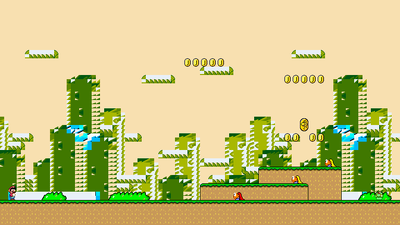
|
Level 0x313E5 | This is a copy of the finished level Donut Plains 1. However, it appears 3 times in the level pointer table: once at level number 0x15, the copy used in-game; once at 0x16, a duplicate; and once at 0x17. The latter is most likely to be a remnant of early game builds, as it is paired with a garbled background, and has the name #2 MORTON'S PLAINS. (The garbled background is the same one used in Yoshi's Island 1; switching to its tileset with a level editor fixes the background glitch, but a glitchy palette still remains.) This name is also attached to one of the copies of Level 0x30200. |

|
Level 0x382C3 | This is a test for a special kind of slope that fixes a bug in the code. It is referenced in the pointer table as Level 0x108. Like 0x17, it has a garbled background, but switching to a certain unused tileset (see #Unused level components below) will fix the background. |

|
Level 0x30263 | This is a short level set in the sky. It contains a sprite not found anywhere else in the entire game, which behaves like the platforms from Forest Secret Area, but with no vertical movement. Due to a glitch in the way the level was originally coded, it is rendered unplayable, but fixing this is straightforward. Due to the nature of the glitch involved, it seems this was a very early level design. Coupled with the fact that it appears before any other level in the ROM except for the "TEST" level, this suggests that it was the first level created for Super Mario World. |

|
Level 0x302BD | This level contains the mushroom scales from Butter Bridge 1. However, they are not functioning correctly. It also contains Super Mario Bros. 3-style Piranha Plants. However, they have slightly glitched graphics, which causes them to have an upside-down flopping Cheep Cheep with an incorrect palette instead of a stem. |

|
Level 0x30338 | A long hall with doors leading to each of the game's bosses. They are out of order from their appearance in the game, and Reznor is not differentiated from the Koopalings; additionally, Big Boo is absent. |

|
Level 0x304EB, 0x30464 | A short and quite glitchy underground level. It makes use of a falling layer 2 effect, which is familiar from the end of Chocolate Secret. |
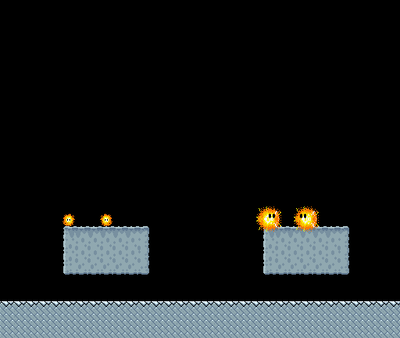
|
Level 0x3059C | A small room with two stone cubes, two Hotheads, and two Lil Sparkies. This was possibly a level to test the Hothead and Lil Sparky enemy data. Despite being a castle-themed level, its background is completely black, like the first room of #4 Ludwig's Castle. |

|
Level 0x305AB, 0x30701 | An early version of #6 Wendy's Castle. It only has small differences from the final version. |

|
Level 0x3073D | An area with one pipe and a long stretch of ground. Due to the level's background music, it is likely that it was supposed to become an underwater stage. The pipe is a brownish-gray color. |
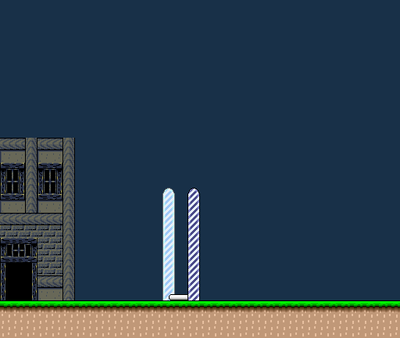
|
Level 0x30875 | An area that is similar to the exit of a Ghost House, but is never used in-game. |

|
Level 0x38218 | A completely empty level. This is most likely used to have a blank background on levels with layer 2 activated. |
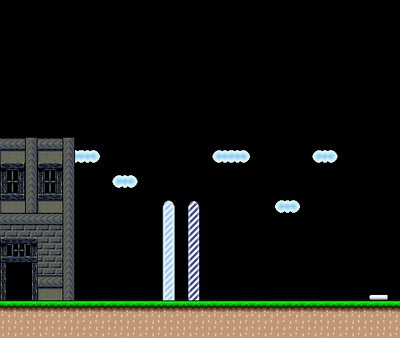
|
Level 0x38260 | Another unused Ghost House exit. This version has some clouds, but the Giant Gate tape is erroneously placed too far from the base. |
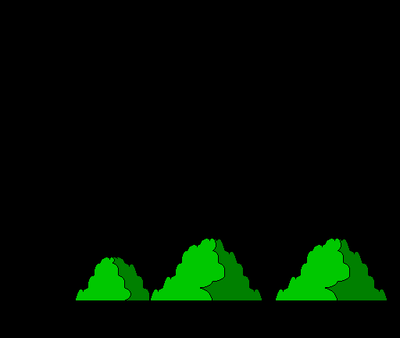
|
Level 0x38281 | A level in which three bushes float in a black void. |

|
Level 0x30584 | A castle-themed level in which an enterable pipe lies adjacent to a large hole. For unknown reasons, the size of the level is 5.5 times longer than the accessible portion. |
Unused level components[edit]
In some cases, some objects were left in the game's code that were never used in a level:
- Three unused graphics tilesets, two for objects and one for sprites.
- The first unused object tileset is labeled "Switch Palace 2", and has no apparent use, as every object that can be used in it appears glitchy.
- The second unused object tileset is labeled "Underground 3", and it combines the rocky foreground of the cave and underwater levels (Underground 1 and 2) with a generic background file that makes the trees for Yoshi's Island 2 and much of the Forest of Illusion, the plains background for much of Donut Plains, the sky background, and the mountain background from Yoshi's Island 3, 4, and much of Chocolate Island. This allows for the possibility of rocky levels similar to those of World 6 in New Super Mario Bros. and New Super Mario Bros. Wii. Unused level 0x382C3, mentioned above, will have its glitchy background fixed if it is switched to this tileset; the background is the same one used in Chocolate Island 3 and Mondo.
- The unused sprite set is simply labeled "Not Used" and combines two generic graphics files: one with the data for Chargin' Chucks and the Amazing Flyin' Hammer Brother and one that is generally used for foreground graphics, such as pipes, cement blocks, ! Blocks, and Turtle Cannons.
- A grassy platform that was used only in a unused level of the game, and can have one of two functions. Normally, it acts much like the flying platforms from Forest Secret Area, but without the vertical movement. However, if a certain property of the level itself is changed, it will act like the floating platforms from Yoshi's Island 3.
- The "Swooper Death Bat Ceiling". This is an object that generates a cloud of Swoopers, but with a blue palette, similar to the cloud of Boos from Donut Ghost House. Because they were scrapped early in development, one of their animation frames is incorrect (looks like half a glass block next to half a Spike Top). Additionally, they lack the correct sound effects.
- A Golden 1-Up Mushroom with wings that floats along and follows the trajectory of a Power Balloon.
- A Red Coin similar to the above, but worth 5 coins, much like in Mario Party DS.
- The Piranha Plant from Super Mario Bros. 3. Similarly to the bat object, its stem appears as a jumping Cheep-Cheep frame because its graphics were never finished. When it is used in the game, it causes VRAM errors due to it loading the wrong graphics file.
- A flying key, which for unknown reasons can hurt Mario. It can be eaten by Yoshi, however, it acts like when Yoshi eats a normal key. When spat out by Yoshi it turns into a normal key. A similar object would later appear in the Nintendo Switch remake of Mario vs. Donkey Kong.
- Several unused decorative grass objects. Most of them are glitchy.
- Doors that can be entered only by Small Mario, but if the door is in midair, Small Mario must be on a Yoshi to enter it. Both normal and Switch Block-activated versions exist.
- A type of Rotating Block that continuously turns.
- A small, glitchy object that has the appearance of a piece of the Midway Gate. Mario cannot interact with it.
- A glitchy part of the Giant Gate. It is attached to the Giant Gate itself.
- An empty Rotating Block. If Mario hits it, it becomes an Empty Block, but gives no item.
- A Prize Block with a Koopa Troopa inside. When it first comes out, it will be trapped in its shell. There are a few glitches with the shell: fireballs will pass through it, and sometimes the graphics do not show up or it will glitch other graphics nearby.
- A Rotating Block that acts like the Wood Blocks from Super Mario Bros. 3. They can be hit from the side, and one version of releases a Cape Feather. Its graphics are incorrect: when it is actually hit, a brown Switch Block appears for the animation.
- A Rotating Block that acts like a cement block.
- A "large background area" that has no use, and is glitchy. Depending on the graphics tileset, this can show up as:
- A very large, very glitchy bush (grass levels)
- A bunch of X's (Switch Palaces and Yoshi's House)
- Castle rocks (castles)
- Glitchy line guides similar to the ones that elevators, saws, and Fuzzies ride on (athletic levels like Cheese Bridge Area)
- Glitchy rocks (underground levels)
- Glitchy porthole windows (Ghost Houses)
- An unknown glitchy object (unused Switch Palace 2)
- A glitchy canvas object (the Castle 2 tileset that was only used in Room #3 of Front Door)
- A glitchy cloud/bush-like object (forest and cloud levels like much of the Forest of Illusion)
- Glitchy clouds (the Ghost House 2 set that was only used at the entrance to Sunken Ghost Ship)
- A cage which would be used on an auto-scrolling level. Mario would be held inside, and would have to dodge obstacles.
- An invisible object that would initiate a level that had both horizontal and vertical components. This is never seen in the final game, in which all levels must be either horizontal or vertical, but not both.
- A different version of the Skull Raft from Vanilla Dome 3. They are much harder to use than the skulls of the final game.
- A Blue Coin, acting as the ones from Super Mario Bros. 3. Hitting a Switch Block will turn these Blue Coins into Magenta Blocks;[4] however, the code that transforms coins into solid blocks is not applied to this type, and it can still be collected as normal.
- A glitchy part of the Midway Gate that cannot be interacted with.
- Unused levels which play the final battle with Bowser themes.[citation needed]
- Through hacking, the "No Yoshi" level intro from castles/fortresses and Ghost Houses can be used in any level with the same effect. However, the castle or Ghost House front would be replaced by a prohibition sign with a Yoshi on it.
- Dino-Rhinos may have once been intended to breathe fire like their smaller counterparts. Sprites of Dino-Rhinos in the same fire-breathing pose as Dino-Torches can be seen in graphics files in tile editors. The idea would be used in Paper Mario: Color Splash 26 years later.
- Unshelled Koopas were originally going to stand upright instead of hunching over like in the final game. Upright-standing unshelled Koopas would later appear in Super Mario World 2: Yoshi's Island.
An early, non-animated version of the Berry tile (not to be confused with the non-animated Berry sprite, which has a distinct appearance from both the animated and non-animated tiles) is technically used in the game, as it is loaded into VRAM at the beginning of each level, but the instant the level starts, that area of the tileset is immediately overwritten with the standard Berry tile, making it impossible for this early Berry design to be seen.
In addition to the above, it appears that the game was intended to have translucency effects in use on some levels. These effects can be seen in some early screenshots, but are never used in the final game. However, they work perfectly when accessed by hacking the final game, aside from the fact that all Message Blocks will appear blank due to their text sharing some settings with the translucency effects.
Flying Red Coin
Flying Key
Magenta Empty Block
Red berry tile briefly in VRAM
Unused map screen sprites[edit]
The game's data contains four sprites implemented for the Map Screen that were never used in the final game:
| Image | Description |
|---|---|
| A Lakitu which circles around Mario's head on the overworld map. It has functionality to fly directly towards Mario, implying that it may have been meant as an overworld enemy encounter, similar to the Hammer Brothers from Super Mario Bros. 3.[5] | |
| A blue bird which flies around Mario's head like the Lakitu, but will follow him to the submaps, except for Vanilla Dome. | |
| An animated Piranha Plant. | |
| A Koopa that resembles Morton. It can force Mario to enter a level, like the Hand Traps of Super Mario Bros. 3. It ambushes Mario on the overworld. Because it was not finished, it corrupts Mario's position on the overworld map, and thus makes the game unplayable except for level 0, which is a never-ending bonus game. Three copies of this sprite were actually used in the game. However, due to the specific setup of the overworld, players will never see them on an unmodified copy of Super Mario World. |
Debug functions[edit]
Using the Super Mario World ROM and a hex editor, players may access debug functions that were left in the game.[6] These include:
- The ability to cycle through Mario's different forms using
 up +
up + .
- The ability to place Mario anywhere in a level using
+
. This can also be performed using a Game Genie code.
- The ability to play in slow motion.
- The ability to win a level with
+
. If the player holds
or
while doing this, they will reach the secret exit of the level.
- The ability to have Super Star invincibility for an unlimited time.
- The ability to change Yoshi's colors in the overworld with
.
References[edit]
- ^ Grooveraider (August 10, 2011). Parents Upset Over New Nintendo Console - Super Nintendo - Circa 1991 (01:36). YouTube (English). Retrieved November 2, 2024.
- ^ GameXplain (September 28, 2017). Bizarre Early Yoshi Design Revealed by Super Mario World's Developers (and Yoshi Abuse?!). YouTube (English). Retrieved November 2, 2024.
- ^ TCRF. Development:Super Mario World (SNES)/Sprites. The Cutting Room Floor (English). Retrieved March 21, 2024.
- ^ "Not to be outdone by its crimson counterpart, there is an unused Blue Coin in the game’s code as well. This Coin has the unusual effect of turning into a Magenta Block when the player hits a P-Switch." – Playing With Super Power: Nintendo Super NES Classics eGuide, Super Mario World 16 Bits Tab. English.
- ^ Kaizoman666 (December 23, 2024). "huh. that unused Lakitu overworld sprite that SMW has was apparently intended for more than just a decoration, it actually has some code to fly directly towards Mario when a certain flag is set. so it was probably an actual enemy encounter at one point". X (English). Retrieved March 11, 2025.
- ^ SMW Memory Map. SMW Central (English). Retrieved November 2, 2024.


